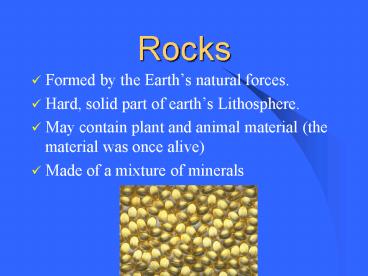Rocks - PowerPoint PPT Presentation
1 / 14
Title:
Rocks
Description:
Rocks Formed by the Earth s natural forces. Hard, solid part of earth s Lithosphere. May contain plant and animal material (the material was once alive) – PowerPoint PPT presentation
Number of Views:76
Avg rating:3.0/5.0
Title: Rocks
1
Rocks
- Formed by the Earths natural forces.
- Hard, solid part of earths Lithosphere.
- May contain plant and animal material (the
material was once alive) - Made of a mixture of minerals
2
Minerals
- Forces inside Earth or on its surface form them.
- Basic building blocks of rocks.
- Made of one or more elements or chemicals.
- Metals iron, copper, aluminum, gold
- Gems diamonds, rubies, emeralds
3
Color
- Easiest property to observe, but not the best for
identification. - Use words like light, dark, streaks, spots,
bright, dull, shiny
4
Rocks and Minerals
- A GEOLOGIST IS A SCIENTIST WHO STUDIES ROCKS
- To learn about Earths history
- To find uses for rocks to make our lives more
comfortable
5
Texture
- How the R/M feels, refers to the size of the
pieces that make up the rock - fine, coarse, granular, sandy, greasy, smooth
6
Layers
- Layers cant be observed in our kit, the samples
are too small - Geologist observe layers in formations of
sedimentary rock - like the
- Grand Canyon!
7
Cleavage
- The way some minerals break
- Split in sheets, cubes, right angles.
- Salt has cleavage in three directions.
- Biotite has perfect cleavage
- in one direction.
- Feldspar has cleavage in
- two directions.
8
Mohs Hardness Scale
- If a mineral can be scratched by a
- Fingernail 1-2
- Coin, but not a fingernail 3-4
- Steel Nail, but not a coin 5-6
- Diamond, but not a steel nail 7-9
- A Diamond has a hardness of 10
9
Acid Test
- The acid will react by bubbling or fizzing.
- 1.Put on safety goggles.
- 2.Place R/M in a cup.
- 3. Place one drop of acid on the rock.
- 4.Record results. Did it fizz?
- 5.Blot the R/M dry with a towel.
10
Streak Test
- The streak is the color of the powder left by the
R/M - If a R/M doesnt leave a streak, it has a
hardness of 8-9 - 1. Rub a R/M across the streak plate once.
- 2. Observe and record the color of the streak or
if there was no streak.
11
Electricity Test
- To test a R/M to see if it
- contains metal.
12
Sedimentary Rocks
- Formed by weathering by wind and water break up
rock. - Made from bits of rock, sand, mud, clay, and the
remains of dead plants and animals. - Rivers, streams, and gravity carry the sediments.
- One layer of sediment after another settled.
- Minerals in the water and the weight of the
layers, cement the sediment together.
13
Igneous Rocks
- Formed by hot melted rock material, magma, which
cools and hardens (solidifies). - Intrusive igneous
- cools slowly and hardens
- inside the earth.
- Extrusive igneous
- cools quickly on Earths
- surface after being
- ejected from volcanoes.
14
Metamorphic Rock
- Formed from igneous, sedimentary, or metamorphic
rocks that have been changed by heat and
continental pressure. - Meta change Morphic form

